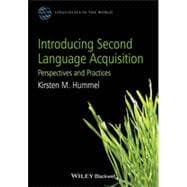Introducing Second Language Acquisition: Perspectives and Practices represents a clear and concise introduction to the main concepts, issues, and debates in second language acquisition studies aimed specifically at undergraduates encountering the topic for the first time.
- Follows six fictitious language learners throughout the text whose stories serve to introduce various concepts and issues
- Contains specific chapters on first language acquisition and bilingualism, as well as explicit references to the most recent and important research
- Covers key topics including acquisition contexts, theoretical perspectives, language teaching methods, second language development, and individual differences (such as age, aptitude, and motivation)
- Grabs student attention with lighthearted cartoons that illustrate and reinforce key ideas
- Features a full range of pedagogical tools to aid student learning, including “language learning in practice” textboxes; bolded new terms defined in the margins; an end-of-book glossary; self-assessment and classroom discussion questions; exercise and project ideas; and further online viewing sections









